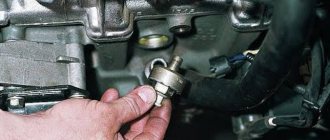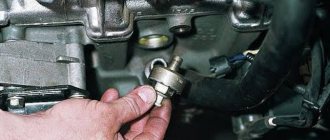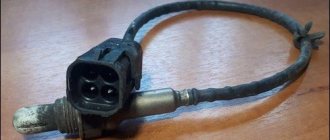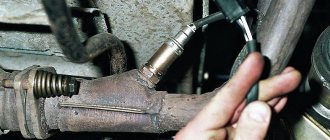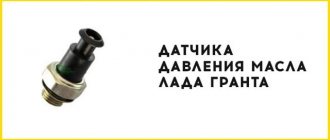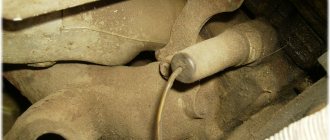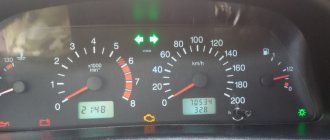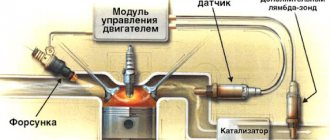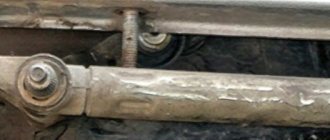A device designed to detect detonation in a car is part of the engine control system. Absolutely all vehicles are equipped with these elements, including the VAZ 2115.
The knock sensor is used to monitor the stable operation of the engine. If there is some kind of malfunction, it starts knocking.
The sensor should warn of a possible electrical impulse that occurs during ignition in the power unit. The fuel may detonate in the cylinder, which is also indicated by this element. The sensor is similar in its action to a piezoelectric element. The size of the sensor is small, no larger than a matchbox.
What is the knock sensor responsible for and what does it consist of?
The knock sensor monitors the process of turning on the car engine and ensures its normal functioning.
The device consists of the following parts:
- Vibration plates.
- Wires that are used to supply a signal.
- Braids.
When knocking, the sensor emits a signal of a certain voltage, which is then sent to a monitoring device that processes it. The controller sends a signal to the ignition timing. This impulse depends on the strength of the received signal. The process occurs very quickly, within a fraction of seconds, so it is not noticeable for observation.
The knock sensor on the VAZ 2115 is located in the engine block, between the second and third cylinders. The sensor can be one- or two-contact. It depends on the car engine.
Observations show that the sensor is a fairly reliable device that can function for several years. But, like any device, it can fail and begin to show signs of malfunction.
Knock sensors for the VAZ-2115 are available in two variations:
- Resonant in the shape of a barrel.
- Broadband, tablet-like.
Installation of a knock sensor can only be done when the car has an automatic ignition system. Otherwise, it cannot be installed. Carburetor models are not equipped with such elements. Typically, the price of a sensor may vary depending on the manufacturer.
Knock sensorCost, in rubles
| Knock sensor VAZ 2110/2115/GAZ 406 Startvolt VS-KS 0110 | 200 rub. |
| Knock sensor for VAZ 2110, 2115, GAZ 406 VSKS0110 Startvolt VSKS0110 | 350 rub. |
| Knock sensor for VAZ 2110 2115 GAZ 406 (vs-ks 0110) Startvolt art. vs-ks-0110 | 250 rub. |
| Knock sensor for VAZ 2110, 2115, GAZ 406 VSKS0110 | 650 rub. |
If the sensor urgently needs to be replaced, then you need to purchase and install it as soon as possible. All car enthusiasts are very concerned about the cost of purchasing new elements. It is small and, as a rule, depends on the quality and country of origin.
Checking and replacing the knock sensor
Failure of the knock sensor on a VAZ-2115 can occur for a number of the following reasons, including:
- Damage to the device itself.
- Broken signal wire or shielding braid.
- There is a malfunction in the engine control unit.
You can get an idea of the stable operation of this device by looking at the car’s instrument panel. There is a “Check-Engine” sign on the panel. If it does not light up, then the device is functioning normally. When there is a breakdown, the icon on the dashboard lights up. This means that the device does not work and needs to be replaced.
There are times when a sensor malfunction message is not received on the dashboard. This situation is possible when the electrical circuit breaks. Problems associated with the sensor can be seen by an increase in fuel consumption. If it is faulty, the indicator increases.
In this case, first of all, you need to check the integrity of all connection wires and contacts and, if necessary, clean them.
There are also several errors that appear during computer diagnostics of a car and which indicate a failure of the knock sensor:
- Error code 0325 indicates that there is a break in the electrical circuit of the external part of the sensor.
- Error code 0326, as well as 0327, indicates that a low pulse is being received from the sensor.
- Error number 0328 indicates that the signal level from the sensor exceeds the norm.
To check the functionality of the knock sensor, you must perform the following steps:
- Prepare the necessary tools: a wrench for tightening and unscrewing parts located in hard-to-reach places by 13 or 22 mm, a screwdriver, a voltmeter.
- Remove the sensor from its installation location.
- Set the voltmeter to operate within 200 MV.
- Connect the sensor to a voltmeter.
- Tap the body of the part with a hard object.
- Observe changes in the device readings, depending on the frequency of blows to the body.
- If the information from the sensor does not change when tapping, then the sensor is faulty and needs to be replaced.
Practice shows that you should purchase the necessary equipment from a trusted supplier. If the product is of poor quality, then other elements that are closely related to it may fail. If in doubt, the sensor can be diagnosed at a service station using special equipment.
A breakdown of the knock sensor is dangerous for the operation of the car engine, as the fuel begins to detonate. To replace the knock sensor, you need to unscrew it using a wrench, disconnect the wires from it and install a new sensor.
Thus, we can conclude that the knock sensor on the VAZ-2115 is a necessary element for the stable operation of the car. It is important that the sensor is always in good condition, since only in this case can it promptly report possible breakdowns in the system.
In addition, this car, like any other, needs timely diagnostics. It is thanks to this that any breakdown can be prevented, which will save unexpected financial costs.
REMOVAL AND REPLACEMENT
Replacing the DD is an extremely simple process. You can change the knock sensor of a VAZ 2114 within 5 minutes; for this you only need a 20 or 13 socket wrench (depending on what specific type of sensor is installed on your fourteenth).
First, let's figure out where the knock sensor is located. It is located directly on the engine cylinder block, between cylinders 2 and 3 (on the radiator side). You can see the location of the DD in the photo.
Replacement of the unit is carried out in the following sequence:
- Turn off the engine ignition and open the car hood;
- If you have a resonant DD, remove the power cord from it and use a 22nd socket wrench to unscrew the device from the socket. If you have a strip-type DD, it will be held on the cylinder body with a nut, disconnect the wiring and unscrew it with a 13mm wrench;
- The new DD is installed in the same way. The thread must be tightened tightly enough so that there are no problems with the weak signal of the device, but, again, without fanaticism.
Now you know where the knock sensor is located and how to check and replace it. Have a good ride without any breakdowns!
VAZ 2115 knock sensor signs of malfunction
Each car includes a large number of different sensors in its design. These devices are necessary to monitor the status of the main components of the car and transmit information to the electronic control unit. Based on the received data, the ECU adjusts the operation of a particular system and makes appropriate changes if necessary.
How does the sensor work and why is it needed?
The operation of the mechanism is based on the principle of a piezoelectric element. This means that if vibration of a different nature occurs in the engine cylinder, a signal will be transmitted to the ECU using electronic pulses. In turn, the final element in this chain will make changes to the operation of the ignition angle.
The fundamental difference between a resonant type device is that it is capable of capturing only noise at the detonation frequency.
The broadband mechanism is superior to its counterpart in that it has a wider range of capabilities. Such a sensor is capable of capturing noise of various frequencies, which undoubtedly gives the vehicle system additional stability.
The devices operate on different principles, therefore, if the resonant sensor breaks down, it cannot be replaced with a broadband one. The situation is similar in the opposite case. If there is an urgent need to replace or change the operating principle of the mechanism, you will have to purchase a new control unit.
Main symptoms of a malfunction
If the VAZ-2114 knock sensor begins to function incorrectly, then in most cases the driver will be able to notice a flashing Check Engine light on the dashboard. At the same time, it is easy to notice a malfunction by the very behavior of the car. The car accelerates poorly, does not overtake, and “chokes” when going uphill. The engine is unstable and shows obvious signs of failure. Other symptoms include:
- frequent overheating of the motor;
- when you press the gas pedal sharply, a detonation knock is clearly audible;
- The on-board computer generates an error, the interpretation of which indicates a sensor malfunction.
Detonation knocks often occur due to low-quality gasoline. If all of the above symptoms are present, it is best to conduct a full computer diagnostic of the car. Monitoring will allow you to determine at which stages of engine operation the worst performance is observed, and computer diagnostics will also allow you to find out the error code of the knock sensor.
Diagnostics can detect faults such as an open circuit, signal level exceeding or its value being too low.
If the diagnostics determines that the knock sensor is faulty, you still need to make sure that the device is not functioning correctly.
see also
Checking DD at home
How to check the knock sensor of a VAZ 2114 at home? It is possible to determine the performance of the mechanism using an ohmmeter or digital voltmeter. The first allows you to determine the resistance, and the second - the voltage between the contacts. A correctly functioning VAZ 2114 knock sensor has an almost infinite resistance. If this indicator is completely absent, then the mechanism must be replaced.
RTD
Controls the functions of the fuel pressure regulator. As a rule, a VAZ is equipped with a mechanical type device that is not interfaced with an ECU. Consequently, the failure is not detected by the system. In this case, problems usually arise:
- regarding engine starting;
- increased fuel consumption;
- excessive CO content in the exhaust.
In 2115 it is installed on the ramp and is connected by a fuel return to the gas tank, and a hose to the air inlet manifold. The serviceability of this sensor can be determined using a pressure gauge connected directly to the fuel rail. Normally at idle the readings should be:
- up to 2.4 bar if the vacuum tube was put on;
- up to 3.25 if removed.
Low pressure often also indicates that the fuel pump is faulty. At the same time, a high level indicates a free flow of fuel from the line back into the tank.
If the RTD fails, the following malfunctions are observed:
- the engine is running unsteadily;
- stalls at idle;
- crankshaft rotation speed is too low or high;
- loss of engine power;
- excessive consumption of gasoline.
Knock sensor for VAZ 2115 - diagnostics, repair, where is it located
Now you will find out what it’s like to look for something without knowing what!!!
Well, I'm tired of this problem with the loss of engine speed during acceleration. The car doesn't drive and that's it. And this car is Kalina 1, 8 valves, 2012. The knock sensor error P0327 kept popping up. Open circuit or failure of the DD sensor.
At first, I often climbed under the hood and removed the chip, slightly bent the contacts on the sensor and the error seemed to disappear for a while. Then she appeared again.
But when driving calmly, you practically don’t notice any dips in the engine’s operation. And my driving style is that of a pensioner. On a station wagon you don’t want to stomp on the throttle.
But recently, I very often began to run into the reluctance of my white barrel to accelerate as intended by the manufacturer. And one fine sunny autumn day I went to the store to buy a knock sensor, deciding that it was in it that the problem was hidden, namely in its contact group.
And so the sensor was purchased at the nearest auto parts store for some 165 rubles. It immediately seemed to me that this price was very low for such a part. Even on the Internet the prices were almost twice as high.
Comparing the old and new sensors. The contacts of the new sensor are very crooked. On the new 4B - on the old 2B.
I installed a new sensor and went for a ride in the car on business.
How did she go... Wow. I was literally tearing it out from under myself!
Yes, self-hypnosis is a great thing.
I arrived home to the hut, looked at the mistakes and my hands sank to the very ground from grief. Error again. Once again the knock sensor was lost and the ECU couldn't find it. Sadness.
But the morning is wiser than the evening. And the next day I decided to check the two sensors for their performance on a multimeter.
It turns out that if you connect the multimeter probes in the constant voltage position at around 200 mV to the sensor contacts. And squeeze the sensor with your fingers, then voltage surges will appear on the multimeter. These are the very impulses that must enter the ECU to adjust the ignition angle.
And to my surprise, the new sensor was silent. No matter how I squeezed him or pounded him, simulating the operation of the engine, he remained silent. The multimeter showed 000. But the old sensor decided to show what it was capable of and in all its glory gave out everything that was required of it.
Unfortunately, I didn’t think of filming how silent the new sensor was. I took it to the store and asked to exchange it for a working one. But it turned out that all the sensors that they tried to give me as replacements were dummies. THOSE. they also did not respond to pressure. There were no impulses.
The seller, to put it mildly, was taken aback by this situation with the sensors, because the 6 sensors from the counter were dummies. Or maybe the whole party.
I was asked to check an expensive Bosh DD for 1000 rubles. He turned out to be completely fine. But I refused to take it, because I decided that the old friend was better than the new two.
Arriving at the car, I reached into the sensor wiring. I took the chip off the DD. I took the ECU out from under the glove compartment.
ITELMA 11183-1411020-52
I removed two connectors from it. I found on the Internet which contacts receive signals from the DD. These are A3 (from 1 DD contact) and B3 (from 2 DD contacts).
How to check the knock sensor of a VAZ 2114-2115 at home?
A device designed to detect detonation in a car is part of the engine control system. Absolutely all vehicles are equipped with these elements, including the VAZ 2115.
The knock sensor is used to monitor the stable operation of the engine. If there is some kind of malfunction, it starts knocking.
The sensor should warn of a possible electrical impulse that occurs during ignition in the power unit. The fuel may detonate in the cylinder, which is also indicated by this element. The sensor is similar in its action to a piezoelectric element. The size of the sensor is small, no larger than a matchbox.
Where is the knock sensor located?
In order to find the DD you need to open the hood and look at the engine. Between the second and third cylinders there is a knock sensor unit. If the engine is 16-valve, then due to the larger connector, the sensor may be less noticeable, although it is located in the same place.
There are two types of knock sensors: broadband and resonant. Resonant sensors can only detect a certain detonation purity and are shaped like a barrel. A wideband sensor, using noise, detects the entire detonation band as a whole and is more similar in shape to a tablet. Mostly broadband ones are used in cars; their cost is approximately 200–400 rubles.
Resonant ones are used much less frequently and finding them in stores can be a big problem; the cost of such sensors reaches 3,000 rubles.
List of errors DD VAZ 2114
- Error code 0325 – the wiring supplying power to the knock sensor has broken. This error can be caused by oxidized DD contacts. Contacts need cleaning. In addition, problems with the timing belt can lead to it, so it also needs to be checked (perhaps it has jumped a couple of teeth, then you need to set everything to the marks).
- Error code 0328 - high-voltage wires are faulty. However, in this case, again, there is a possibility of the timing belt jumping.
- Error code 0326, 0327 – weak signal from the knock sensor. To eliminate this problem, you need to clean the connection contacts of the VAZ 2114 DD. Also, errors can be caused by weak tightening of the sensor.
Signs of a malfunctioning knock sensor
Of course, to detect a problem, it is best to go to a service center, but to identify a malfunction of the knock sensor, it is not necessary to carry out a full diagnosis. Some external factors can indicate a breakdown and inform the driver about the malfunction even before diagnosis:
- Increased fuel consumption;
- The “check” light on the car is constantly on, or periodically during acceleration;
- The internal combustion engine begins to stall;
- When accelerating, you feel that the car is losing speed;
- The engine periodically overheats due to incorrectly set ignition;
- When adding gas, a knocking sound is heard in the car engine;
- During diagnostics, a knock sensor error is displayed.
When an error occurs, a special code is displayed, and depending on the error code, you can determine the extent of the problem and begin to resolve it.
Code 0325 means that the contact is not being made, and the wires may have broken. Wiring breaks very rarely, so most often you just need to clean the contacts. If it doesn’t help, then you can check the timing belt, and if it comes off, return it to its place according to the marks.
Code 0326 (0327) - means that the contact is present, but the signal is received very poorly. It is necessary to clean the contacts and then check how well the sensor is secured. If necessary, tighten the tension.
Code 0328 - the problem is a faulty wire, there is no contact, or the timing belt may come off.
Functionality check
If typical signs of a malfunction are detected, it is necessary to check the operation of the DD. To do this you will need a regular screwdriver and a tester.
A tester, also known as a multimeter, can be purchased at any automotive store. It is inexpensive, about 500-600 rubles, and will come in handy in the garage many times (it is used to check all systems and devices of the car that consume electricity), so there is no need to skimp on the device.
The DD functionality check is performed as follows:
- We dismantle the sensor (how to do this is written in the next section of the article);
- We connect the multimeter probes to the DD contacts (if it is two-contact), if it is single-contact, the first probe to the wire, the second to the device body;
- We switch the tester to voltmeter mode and set the upper measurement limit to 200 mV;
- Tap a screwdriver (or any metal object) on the sensor body;
- If the device is working properly, the multimeter will show voltage surges, the magnitude of which should be directly proportional to the force of the impact (this indicates that the device retains the ability to convert mechanical energy into alternating current). If the multimeter readings do not change, the DD does not work.
Article on the topic: Checking the operation of the generator on a VAZ 2114: how many volts (V) it produces
If you find out that the device itself is working properly, but DD errors are displayed on the on-board computer or the car is not working as it should, the problem is most likely in the oxidized contacts of the sensor. Treat them with WD-40 or a similar solvent, install the DD in place and check the result. If that doesn't help, replace the knock sensor.
How to check the knock sensor
Only a tested and inoperative knock sensor needs to be replaced. Therefore, it is necessary to check before replacing. You don’t need any special knowledge to do this, the main thing is to stock up on a multimeter.
We connect the multimeter and close the contacts. If it is working properly, the multimeter will display infinite numbers.
If the sensor is faulty, the values may not be displayed or may be to the 10th power.
Before checking the DD, you need to understand whether it is single-contact or two-contact.
How to remove a headlight on a VAZ 2114, excluding accidental mistakes
The check is carried out with the ignition off. When using a two-pin sensor, it must be disconnected from the battery.
How to check, step by step instructions:
- Take a multimeter and switch to 200 mV;
- After this, we close the probes on the contacts, regardless of where the plus and minus are located;
- We find a solid object and, when connecting the multimeter, hit the sensor;
- We look at the values that are displayed. 20 to 40 mV are normal values and may vary depending on the strength of the impact.
If the multimeter does not show the correct value, then it is necessary to replace the non-working device.
Description of the phase sensor
First, let's look at the installation location, purpose, and design features of the DF.
Location, purpose and device
In VAZ 2114 and 2115 cars, the phase sensor is a device used to obtain information about the operation of the power unit and further transmit this data to the control unit.
Checking DD yourself
The knock sensor is located between cylinders 2 and 3 on the radiator side directly on the engine block. Checking the knock sensor is a simple matter, especially if you have ever looked under the hood of the fourteenth.
Replacing the knock sensor VAZ 2114
- The key end is 13 for a single-pin DD (resonant) and 22 for a two-pin DD (broadband)
- Simple screwdriver
- Multimeter
How to check the knock sensor
The first thing to do is remove the DD. It’s easier to remove the single-pin one: don’t touch the ignition, turn it off and unscrew the sensor from the engine. The two-pin one is more complicated: we also don’t touch the ignition, but we also need to remove the negative from the battery. Then, remove the wires of the block, unscrew the DD fastening and remove it.
Second, we switched the multimeter to a voltmeter and set the limit to 200 MV. We connected it to the DD and carefully hit it with some piece of iron (the same screwdriver). When impacted, the voltage should jump; if there is no jump, the sensor is dead, go to the store for shopping.
When a two-pin DD is connected, its terminals cling to the multimeter, when a single-contact DD is connected, one contact and its body are clinging.
Third, we look at the wiring, as already mentioned, most often it’s a matter of frost, or broken contacts.
A simple plan on how to check the knock sensor in your garage with properly trained hands.

